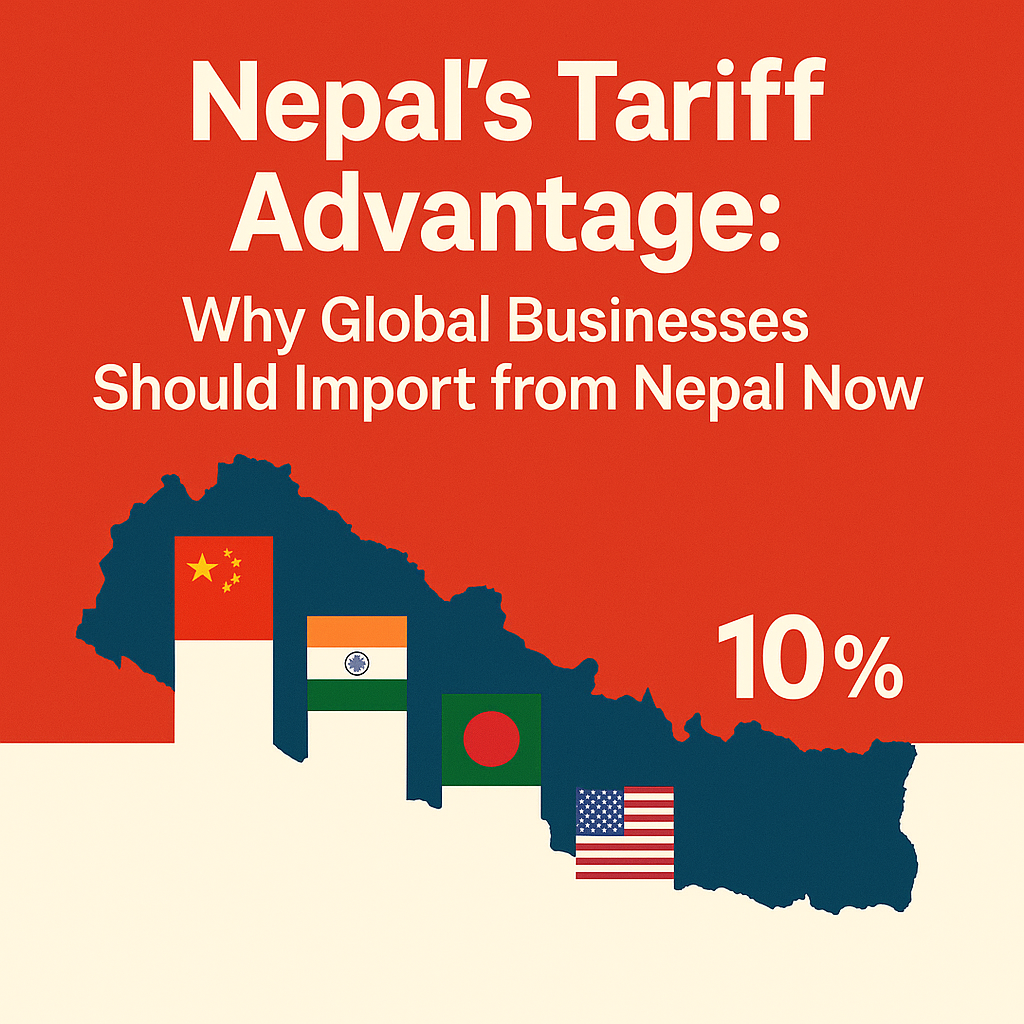- Home
- About
- Products
- Services
- Sustainable, Ethical Sourcing & Compliance
- Production scheduling and Expediting
- Supplier Verification
- Product Testing
- Quality Control
- Sample Development
- Packaging Sourcing & Development
- Drop Shipping & Amazon Fulfillment
- International Logistics
- Impact Reporting
- Branded Merchandise
- Product Photography
- Vendor Enrollment
- Policies
- Blog
- Contact Us
- Home
- About
- Products
- Services
- Sustainable, Ethical Sourcing & Compliance
- Production scheduling and Expediting
- Supplier Verification
- Product Testing
- Quality Control
- Sample Development
- Packaging Sourcing & Development
- Drop Shipping & Amazon Fulfillment
- International Logistics
- Impact Reporting
- Branded Merchandise
- Product Photography
- Vendor Enrollment
- Policies
- Blog
- Contact Us
Nepal’s Tariff Advantage: Why Global Businesses Should Import from Nepal Now
- Sourcing Nepal | Best Sourcing Company in Nepal
- Sourcing Facts
- Nepal’s Tariff Advantage: Why Global Businesses Should Import from Nepal Now

Nepal’s Tariff Advantage: Why Global Businesses Should Import from Nepal Now
In a rapidly changing world of global trade, where tariffs, duties, and political uncertainties impact sourcing decisions, one Himalayan nation is quietly emerging as a strategic sourcing hub—Nepal.
While the U.S. tightens trade policies and increases import tariffs on many countries, Nepal enjoys a unique position. Under current trade policy discussions spearheaded by Donald Trump and other political leaders, tariff rates on key countries like China (245%), Bangladesh (37%), India (26%), Pakistan (29%), and the European Union (20%) have been proposed or are already in effect.
Yet Nepal remains largely untouched—with only a 10% tariff on most exports to the U.S., and duty-free access for 77 product lines under the Nepal Trade Preference Program (NTPP). This makes Nepal not only a competitive alternative but a high-potential sourcing destination for international businesses across industries.
The Cost Advantage: Nepal’s Low Tariff Rates
Let’s get straight to the point. Tariffs play a huge role in pricing, and in today’s competitive market, every percentage counts.
A 10% tariff means lower landed costs, better margins, and a stronger position for retailers and wholesalers competing in price-sensitive markets.
Country | Average Tariff to U.S. |
China | 245% |
Bangladesh | 37% |
Pakistan | 29% |
India | 26% |
European Union | 20% |
Nepal | 10% |
But that’s not all—77 product categories from Nepal enjoy zero duties when exported to the U.S., thanks to the Nepal Trade Preference Program, introduced by the U.S. Congress as part of its broader efforts to support Nepal’s economic growth after the 2015 earthquake.
Nepal Trade Preference Program (NTPP): A Rare Opportunity
In 2016, the U.S. enacted a special trade program for Nepal that provides duty-free access for 77 product lines, many of which are niche, handmade, and high-demand items. This was designed to boost Nepal’s export capacity and integrate it better into global trade.
Examples of duty-free categories include:
- Handmade carpets
- Felt goods and decorative items
- Pashmina products
- Jewelry and silverware
- Home textiles
- Wool apparel
- Glass beads and sculptures
This is not a benefit that many developing nations enjoy—making Nepal’s position even more valuable in global sourcing.
Why Import From Nepal?
Instead of sourcing from countries facing higher tariffs, delayed shipments, and rising political tensions, importers can turn to Nepal for cost-effective, ethical, and high-quality products. Here’s why:
1. Lower Tariff Costs
A 10% tariff gives importers immediate savings—especially for bulk orders. When profit margins are thin, this becomes a major competitive advantage.
2. Zero-Duty Access for 77 Products
Under the NTPP, eligible products from Nepal enter the U.S. market duty-free, allowing importers to keep pricing attractive while maintaining profitability.
3. Unique and Handmade Product Offering
Nepal is globally known for:
- Artisan-crafted home decor and handicrafts
- Eco-friendly pet products like felt toys and Churpi (dog chews)
- Natural wellness goods: incense, herbs, spices, and essential oils
- Ethical wool and hemp-based yoga and lifestyle products
These products appeal to modern consumers who value authenticity, natural materials, and sustainability.
4. Ethical and Sustainable Production
Nepali producers often work with local cooperatives, women-led groups, and small artisan collectives. Many of the products are:
- Handmade, not factory mass-produced
- Made from natural or recycled materials
- Produced under fair-trade or ethical labor practices
This aligns perfectly with the values of conscious consumers and sustainability-focused brands.
5. Rising Export Potential
Nepal’s export ecosystem is growing. In the fiscal year 2023/24, Nepal exported goods worth NPR 17.31 billion to the U.S. alone, signaling steady growth in trade relations and trust in Nepali goods. This is a clear indicator that Nepal is ready to supply the world with more.
What Products Can You Import From Nepal?






Nepal’s product diversity is impressive—combining traditional craftsmanship with growing global trends:
Home & Lifestyle:
- Wool carpets and felt rugs
- Hemp yoga mats and bags
- Handmade candles and incense holders
Health & Wellness:
- Herbal teas (e.g., butterfly pea, lemongrass, tulsi)
- Natural spices (ginger powder, Sichuan pepper, turmeric)
- Ayurvedic skincare and massage oils
Pets:
- Churpi (natural dog chews)
- Handmade pet toys from felt
- Organic pet accessories
Fashion & Accessories:
- Pashmina shawls
- Hemp-based clothing
- Handmade silver jewelry
Festive & Gift Items:
- Decorative crafts
- Festival sets
- Custom gift boxes
A Blessing In Disguise For Nepal
Nepal has long been seen as a beautiful travel destination, but it’s now stepping into the global spotlight for trade. With other nations facing trade restrictions, Nepal is benefitting from being low-risk, low-tariff, and high-potential.
Sourcing With Confidence
Whether you’re an e-commerce brand looking for unique handmade products, a wellness company sourcing Himalayan herbs, or a retailer searching for ethical, sustainable supply chains—Nepal checks every box.
By working with verified sourcing partners like Sourcing Nepal, importers get access to:
- Export-ready suppliers
- Custom packaging and branding
- Supplier verification and quality assurance
- International shipping and documentation assistance
Don’t Miss The Moment
As tariffs increase elsewhere and sourcing costs rise, Nepal offers a rare combination of cost savings, product quality, ethical sourcing, and favorable trade terms. For any importer looking to expand, now is the time to explore what Nepal has to offer.
Ready To Import From Nepal?
📧 info@sourcingnepal.com
🌐 www.sourcingnepal.com
Frequently Asked Questions
Nepal enjoys a comparatively low average U.S. tariff rate of just 10%. Additionally, 77 products from Nepal are eligible for zero-duty access under the Nepal Trade Preference Program (NTPP).
The NTPP includes 77 product lines such as:
- Handmade wool carpets
- Felt goods and pet toys
- Pashmina products
- Jewelry and silverware
- Hemp-based textiles
- Glass beads and handicrafts
These products can enter the U.S. duty-free, significantly reducing import costs.
Nepal offers:
- Lower tariffs (10% vs 20–54% in other countries)
- Duty-free access for many products
- Ethical, handmade, and sustainable products
- Less political risk and smoother customs clearance for certain product lines
Not at all! With experienced sourcing companies like Sourcing Nepal, importers receive full assistance—from product selection to documentation, quality control, branding, and international shipping.
Yes. Nepal’s export ecosystem is growing steadily. In FY 2023/24, Nepal exported goods worth NPR 17.31 billion to the U.S., showing strong capacity and trust. Bulk orders, private labeling, and scalable production are all available through verified exporters.
At SourcingNepal, we take pride in being the premier choice for businesses seeking sourcing solutions in Nepal.
Contact Info
Kathmandu, Nepal


